
 View of Pietrelcina, the birthplace of Padre Pio. Map of
the area, in Southern Italy.
View of Pietrelcina, the birthplace of Padre Pio. Map of
the area, in Southern Italy.
Padre PIO 0-15 (1887-92)
Pietrelcina

 View of Pietrelcina, the birthplace of Padre Pio. Map of
the area, in Southern Italy.
View of Pietrelcina, the birthplace of Padre Pio. Map of
the area, in Southern Italy.
Pietrelcina is a rural village of about 3000 souls in the province of Benevento,
in Southern Italy. Pietrelcina is 8 miles distant from Benevento.
Over the centuries the name changed several times: “Petrapolcina”, “Petrapucina”,
“Petrapolicina”, “Petrapulcina”, “Pietr’elcina”, “Pietra Elcina”, “Pietralcina.”[1]
The medieval part of the town is called “Rione Castello”. A castle was there in
1100, destroyed by the earthquakes of 1349 and 1688, and each time rebuilt.[2]
![]()
![]()

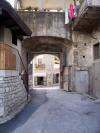 The castle was in reality a “Castrum”, a small town fortified with walls, with
two entry doors, inhabited by military and civilians.
[3]
The castle was in reality a “Castrum”, a small town fortified with walls, with
two entry doors, inhabited by military and civilians.
[3]
![]()
![]()
 The “Rione Castello” is standing on a large rock called “Morgia’ or “Morgione”.
The “Rione Castello” is standing on a large rock called “Morgia’ or “Morgione”.
The houses in Rione Castello are made of rough local stones, attached in rows
one to the other.[4]
One
of the entry doors to “Rione Castello” is called “Porta Madonnella”.
![]()
 The “Pantaniello” well is the center of the town.
The “Pantaniello” well is the center of the town.

![]() Birth Certificate of Francesco Forgione.
Birth Certificate of Francesco Forgione.
The future Padre Pio was born on Wednesday May 25,
1887, at 5:00 PM by Grazio Mario
Forgione, age 26, (1860–1946), and Maria Giuseppa de Nunzio Forgione, age 28,
(1859–1929), in the rione Castello, Pietrelcina. The birth certificate, by the
town officer Giuseppe Sagliocca, states that the parents were “possidenti”,
meaning property and land owners.
[5]
The birth certificate gives also the name of Grazia Formichelli, the midwife
that delivered the boy.[6]
She said at birth: “The baby is born wrapped in a white veil, and this is good
sign: he will be great and fortunate.”[7]
She was also the godmother.[8]
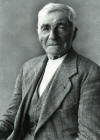
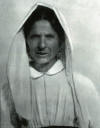 The name of Padre Pio’s father was Grazio, but he was known as Orazio and called
Zi Orazio by his neighbors. The Forgiones were farmers, cultivating their own
piece of land. They had married on June 8, 1881. Both were illiterate. She
brought a dowry of about a hectare of land. They were not poor. There was food
on the table every day. But there was little cash.[9]
The name of Padre Pio’s father was Grazio, but he was known as Orazio and called
Zi Orazio by his neighbors. The Forgiones were farmers, cultivating their own
piece of land. They had married on June 8, 1881. Both were illiterate. She
brought a dowry of about a hectare of land. They were not poor. There was food
on the table every day. But there was little cash.[9]
 The Forgiones had 8 children. The first born was Michele. The second child,
Francesco, died after 19 days. The third, Amalia, died at 20 months. When
Francesco, the future Padre Pio was born, he was given the name of the older
dead brother Francesco. He had also three younger sisters, Felicita, Pellegrina,
and Grazia (who was later to become a Bridgettine nun). The youngest brother,
Mario, died before he turned 1 y. o.[10]
The Forgiones had 8 children. The first born was Michele. The second child,
Francesco, died after 19 days. The third, Amalia, died at 20 months. When
Francesco, the future Padre Pio was born, he was given the name of the older
dead brother Francesco. He had also three younger sisters, Felicita, Pellegrina,
and Grazia (who was later to become a Bridgettine nun). The youngest brother,
Mario, died before he turned 1 y. o.[10]
![]()


![]()












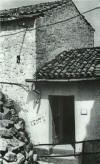 Interior and exterior on the one room Home in Crooked Valley Lane.
Interior and exterior on the one room Home in Crooked Valley Lane.
The dwelling was located in Vico Storto Valle, 27, and 28, later renumbered 32,
and consisted of one room of about 145 square feet, with three external steps to
the entrance.[11]
Inside there was on the right a bed with iron frame and a nightstand; a window
in front, with a basin for face and hand washing, and a chest; on the left there
was another chest and two chairs.[12]
Under the house there was another room, accessed through a trapdoor and also
through a door in the street, were they would keep the donkey, supplies and
tools.[13]
![]()
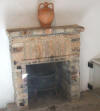

 The two rooms "Cucina".
The two rooms "Cucina".
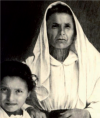 Mamma Peppa with her niece Giuseppina.
Mamma Peppa with her niece Giuseppina.
On the same street, separated by a taller construction belonging to a different
family, there was the other section of the house, consisting of two rooms: the
kitchen and the bedroom. The kitchen had a fireplace and a wooden bench; the
bedroom was used by Francesco and his brothers. Like in most houses at the time:
No plumbing; no bathroom; no running water; no shower; no stove; no electricity.[14]
![]()
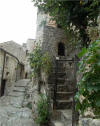

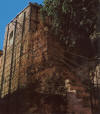
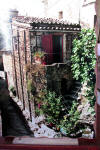




 The single room "La Torretta" in various stages of
preservation.
The single room "La Torretta" in various stages of
preservation.
Nearby there was “La Torretta” (the little tower). It is a room accessible by
outside stairs in the same Crooked Valley Lane, at the #1. The numerous steps
are very steep. The simple room had a bed, a table, and a window. La Torretta
was damaged by the 1962 earthquake, and had to be restored and reinforced. In
this room Padre Pio stayed as a teenager and after ordination to priesthood, to
study, pray, rest, and write letters.[15]
During his stay in Pietrelcina from 1910-16 Padre Pio did not stay for long at
La Torretta because he was in poor health and the steps were too hard to climb.
He stayed in another nearby house, in Via Santa Maria degli Angeli #44.
This house had been bought by his father and brother Michele, when they returned
from America in 1903.
Padre Pio had his own room on the upper level. Here he wrote letters to his
spiritual directors, had frequent apparitions of Jesus and other heavenly
beings, and was tormented by the devil with multiple physical assaults.[16]
![]() Arched entry to maternal home on the right.
Arched entry to maternal home on the right.
 Years later Michele Forgione, brother of Padre Pio, brougth the house on the
left, with entry by outside stairs.
Years later Michele Forgione, brother of Padre Pio, brougth the house on the
left, with entry by outside stairs.
In the first year of marriage the Forgiones lived with her parents.




![]()
![]()
![]()
![]()
 St. Anna church. Outside and inside.
St. Anna church. Outside and inside.
The future Padre Pio was baptized by Don Nicolantonio Orlando in the nearby
Santa Anna's Church on May 26, 1887 the day after his birth, at 8 in the morning
and given the name of Francesco.[17]
The church of St. Anna is small and simple, built on top of the steep side of
the “Rione Castello”, very close to where the Forgiones lived.[18]
Infancy with Angels and devils
When talking about his infancy Padre Pio said that he remembered everything
about it, including when he still was in the crib.”[19]
 Still in the crib he started having the visible companionship of his Guardian
Angel. He later reported in a letter: "The Guardian Angel has been my companion
since my infancy."
[20]
Still in the crib he started having the visible companionship of his Guardian
Angel. He later reported in a letter: "The Guardian Angel has been my companion
since my infancy."
[20]
He started seeing the devils too. Years later he recalled: "When I was in the
crib, and my mom extinguished the lamp I saw those horrible monsters and
screamed terrified. Than mom turned the lamp back on, and the monsters
disappeared, and I stopped screaming."[21]
The devils were constantly lurking around his cradle in the form of hideous
terrifying monsters.[22]
In a letter to Maria Campanile, in November1922, Padre Pio wrote: “The Lord from
my birth showed me signs of a very special predilection.”[23]
As an infant Padre Pio cried long hours through the night. His Father Grazio,
years later, recalled that one night he lost his patience, took the baby and
threw him on the bed saying: “What has been born in the house, a devil instead
of a Christian?” The infant slipped from the bed and fell to the floor. Mamma
Peppa scalded the husband: “You killed my son!” She took the baby in her arms
and realized that there had been no harm.[24]
Recalling the episode at his father’s funeral Padre Pio said: “From that day on
I didn’t cry anymore.”
[25]
Years later Mamma Peppa told Padre Pio: “Son, what a scare you gave me that
night!” Padre Pio: ‘Mom, it was the devil tormenting me.”[26]
Many years later Padre Tarcisio asked Padre Pio: “When did you start suffering?”
Padre Pio: “Since I was in my mother’s womb.”[27]
Giuseppe Faiella
Mama Peppa recalled years later that when the baby was few months old she took
him to the fortune teller of the village, Giuseppe Faiella. He said: “This baby
will be honored by the whole world. A lot of money will pass through his hands,
but he will own nothing.” Mamma Peppa reported herself thinking “Maybe it means
that one day Francesco will go to America, and the whole world will know him.”[28]
[29]
Faiella also said that Francesco would live to ninety eight (Padre Pio died at
eighty one).[30]
Mamma Peppa also recalled that when Francesco was 2 years old he had frequent
belly aches, so she took him to the healer of the village to remove the evil
eye. The healer held him upside down while pronouncing her formulas. Padre Pio
years later recalled the episode: “She held me by the legs, like a lamb.”[31]
[32]
The Forgiones were very religious. When the church bells rang every morning the
family gathered for prayers. They went to church every day and prayed the Rosary
together as a family in the evening. Prayer came before all other activities in
the household.[33]
Around age three recited rosary and other prayers by himself.[34]
At the age of five Francesco had the thought and feeling to consecrate himself
forever to God. At that age the ecstasies and the apparitions began.
[35]
[36]
[37]
He became an altar boy, went to church twice a day, and also every Sunday afternoon went to religious education classes.[38]
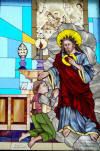 Jesus
Sacred Heart puts his hand on the head of five yars old Francesco (stained
window in St. Anna church).
Jesus
Sacred Heart puts his hand on the head of five yars old Francesco (stained
window in St. Anna church).
One day he felt like not playing with the other kids, and sat in a pew in the
church, and Jesus from the tabernacle made a sign with the hand to come to the
altar, and Jesus put his hand on Francesco’s head.[39]
[40]
The
Sacred Heart this way attested his pleasure in accepting the offering of self to
him.[41]
[42]
When asked later why he never told his mom of the visions he was having, he
said: "I believed that these things happened to everybody".[43]


 The area outside St. Anna's church were Francesco used to
play with his friends.
The area outside St. Anna's church were Francesco used to
play with his friends.
Francesco used to say to his mom: "I don't want to play with the other kids
because they curse".[44]
"Mom, my companions say bad things and offend Jesus”.[45]
He, in agreement with the sacristan Michele Peruto had himself locked in the
church, and the sacristan would let him out at a convened time. He wanted to
pray and meditate alone.[46]
One afternoon he went out dressed in a new garment that his parents had just
bought for him. A few hours later he came home half naked. His response to his
mother’s scolding was: “I gave it to a little boy who needed it more than I
did.”[47]
One Sunday on his way home after Mass he saw Andrianella, a neighbor women,
sitting on her doorstep, stitching ribbon to a skirt. He told her: “You don’t
work today. It’s Sunday.” “That’s what you think, my son.” She replied.
Francesco went home and came back with a pair of scissors, and cut the ribbon in
pieces before the astonished woman.[48]
Fra Modestino's mother Anna Fucci was the same age of Padre Pio and lived few
yards away. She reported that he refused to play with other kids, avoided to
graze the sheep when she was around, he was always with a Rosary in his hands,
and everybody called him "lu santariello nuostro" 'our little saint'.[49]
To his mom who saw him at age 8 beating himself with a chain "I must do it like
they made Jesus shoulders bleed."
[50]
[51]
[52]
Ubaldo Vecchiarino reported that he and his friends, passing by Francesco’s
window, they frequently piled up some stones, and climbing on them they spied
Francesco self-beating with a hemp cord.”[53]
[54]
The priest of the parish, father Giuseppe Orlando reported that Francesco,
despite the objections of his mother, would sleep on the floor using a stone as
pillow.[55]
[56]
The farm "Masseria" in Piana Romana.
The Forgione farm was small, by American standards. It yielded grapes, wheat,
Indian corn, olives, figs, and plums. They also raised sheep, goats, hens,
ducks, rabbits, and occasionally kept a milk cow or two and some hogs.[57]
The farm was located in Piana Romana. On a lane near their plot they had a
cottage were they stored the equipment, kept the animals, and, in the summer,
cooked, ate and slept.[58]
[59]
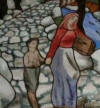 Young Francesco with his mom on their way to Piana Romana.
Young Francesco with his mom on their way to Piana Romana.
One day Francesco and mamma Peppa, on their way to Piana Romana, passed a field
of broccoli. She said: “How good they look! I’d like to have some.” Francesco
replied: “That’s a sin!” Few days later on the same road they saw a tree with
ripe figs. Francesco got a few and ate them. His mom: ”So, it’s a sin to eat
broccoli, but not figs!”[60]
[61]
Padre Pio, recalled years later: “I suddenly got an irresistible craving for
them.”[62]
Padre Pio recalled in later years how he played jokingly with his sisters. Once
he pushed down in the basin Felicita’s head while she was washing.[63]
[64]
Once he made unusable a pair of pants that he disliked, forcing his parents to
buy a new one.[65]
Francesco didn’t go to elementary school. At age six he was assigned four sheeps
and a goat, to take care of them in Piana Romana.[66]
There he met with other children more or less of his age: Maria, Cosimo and
Mercurio Scocca, Luigi Orlando, Ubaldo Vecchiarino called Baldino, Antonio
Bonavita, Margherita de Cianni, Anna Fucci. When he spent the night in Piana
Romana he stayed at the home of aunt Daria.
[67]
Orlando recalled that when they were fighting “Francesco always won because he
was older than me.” He also reported: “Francesco never said a bad word. He was
frequently reciting the rosary.”[68]
During a fight, Francesco was winning, and Orlando said a bad word. Francesco
immediately stopped and run away.[69]
Mercurio and Orlando recalled that Francesco liked to organize processions, and
at Christmas he made with their help the Nativity scene carving the figurines
out of clay.[70]
[71]
They also filled with oil the best snail shells they could find and made lamps
to lighten the cresh.[72]
Baldino reported that Francesco often was kneeling in intense prayer and he had
to tell him: “You, when you pray, you seem to be dead, that you are no more on
this Earth.”
Antonio Bonavita recalled: “The rest of us children were wicked, but he was
always good.”[73]
Mercurio Scocca seeing Francesco constantly absorbed in his thought one day told
Francesco they he knew what he needed: “You need to get married.” Mercurio later
recalled that Francesco run after him with a pitchfork.”[74]
Mercurio also recalled that Francesco frequently organized processions, and he
would lead singing aloud and the other shepherd followed. “We did so many
processions!”[75]
The water well

![]() Margherita De Cianni reported that one day Padre Pio’s father Grazio was digging
a well in Piana Romana. He dug forty feet without finding water. Francesco said
that he would never find water there, and then pointed to a precise spot
somewhere else on field where he would find water. Orazio: “How do you know?”
Francesco: “Jesus told me.” Orazio: “I’ll dig there, but if there is no water,
I’ll throw you in the hole.” He dug seven feet and a copious spring of water
burst out.”[76]
[77]
[78]
[79]
The well has been preserved.
Margherita De Cianni reported that one day Padre Pio’s father Grazio was digging
a well in Piana Romana. He dug forty feet without finding water. Francesco said
that he would never find water there, and then pointed to a precise spot
somewhere else on field where he would find water. Orazio: “How do you know?”
Francesco: “Jesus told me.” Orazio: “I’ll dig there, but if there is no water,
I’ll throw you in the hole.” He dug seven feet and a copious spring of water
burst out.”[76]
[77]
[78]
[79]
The well has been preserved.


 The area of the farm were Francesco grazed sheep and
farmed.
The area of the farm were Francesco grazed sheep and
farmed.
Padre Pio also did farm work on the land that the family owned in Piana Romana.
In 1901 in a letter to his father who had migrated to America, he reported:
“This year corn (granone), as you can imagine, was very little, because we
didn’t get rain on time. We filled only four sacks of it.”[80]
Padre Pio, remembering that age: "I was an unsalted piece of macaroni."[81]
[82]
[83]
[84]
Padre Pio had a scar on the little finger of left hand. He cut himself one day
in Piana Romana when he was asked by his brother Michele to cut grass with a
sickle.[85]
At age
twelve Francesco spent fourty days sick in bed with thyphoid fever. The town’s
physician dr. Giacinto Guadagno said that he had only few days to live.
Francesco said; “If I’m dying I want to seen Piana Romana once more.” He was
taken there by donkey.[86]
[87]
Meanwhile
mamma Peppa cooked a large plate of fried peppers and went in the field. When
she returned the peppers were gone and Francesco was in bed sound asleep with a
red face and sweating profusely. She was concerned. But when he awoke he felt
perfectly well, and confessed that he had eaten the peppers. The indigestion of
peppers had healed him.[88]
[89]
[90]
[91]
Francesco
didn’t like zucchini. One day his mom prepared zucchini parmigiana. He dind’t
eat it, and his mom burst in tears. Recalling the episode he would say: “If I
had known that my mom would have been so displeased, I would have devoured all
those zucchini.”[92]
Francesco
also tried smoking. One day his uncle Pellegrino Scocca
gave him money to buy a cigar. On his way back he decided to light the
cigar and take a puff. He became so ill that he never had a desire to smoke.
“That lesson put a wall between me and smoking.”[93]
[94]
[95]
St. Mary of the angels parish church in Pietrelcina.
Madonna della Libera in procession.
The parish church in Pietrelcina was Saint Mary of the Angel. In the church was
venerated the “Madonna della Libera”, the Patron Saint of Pietrelcina. Every
year the statue, covered with donations from the faithful, especially the
migrants, was taken in procession. For the town it was the main event of the
year.
The archpriest was Don Salvatore Pannullo.
When Padre Pio lived
in Pietrelcina as a Priest, Pannullo kept a close friendship with him.
The Gregaria was an area of open field, just to the right of the parish of St.
Mary of the Angels, were the future Padre Pio in about 1909 used to walk with
the archpriest Salvatore Pannullo, don Giuseppe Orlando, and other altar boys.
Passing by that area he heard a choir of angels singing and bells ringing coming
from an area in the countriside.[96]
[97]
[98]
Years later Padre Pio stated to Orlando that he remembered very well the
episode.[99]
In 1947 the Capuchin convent was opened there, and in 1951 the Holy Family
church was consecrated at the Gregaria.[100]
The archpriest Salvatore Pannullo admired in Francesco three qualities that he
“possessed strongly”: intelligence, sensitivity, and courage.[101]
The town of Altavilla Irpina with the church of the Assumption, and the altar of San Pellegrino were the prodigy happened.
At age
nine, on August 25, 1895, Padre Pio went with his father to Altavilla Irpina for
the feast of Saint Pellegrino. While in the church, a young mother, holding her
deformed sick child, prayed aloud for his recovery. At one point she approached
the altar of Saint Pellegrino, threw the child on it, and said “If you don’t
want to heal him, you got to take him back!’ To the general astonishment the
child fell on his feet, and for the first time in his life he walked. He was
healed.
[102]
[103]
[104]
[105]
[106]
Padre
Raffaele da Sant’Elia a Pianisi reported that, many years later, Padre Pio
narrated to him that episode crying abundantly.[107]
[108]
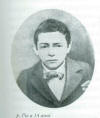
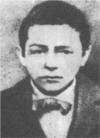 There is a picture of a boy of about age eleven, commonly described as the first
picture of the young Francesco Forgione, the future Padre Pio. However, it could
be a picture of his cousin, Franceschino Forgione.[109]
Franceschino Forgione, son of Padre Pio’s brother Michele Forgione and Giuseppa
Cardone, died of meningitis at the age of eleven.[110]
There is a picture of a boy of about age eleven, commonly described as the first
picture of the young Francesco Forgione, the future Padre Pio. However, it could
be a picture of his cousin, Franceschino Forgione.[109]
Franceschino Forgione, son of Padre Pio’s brother Michele Forgione and Giuseppa
Cardone, died of meningitis at the age of eleven.[110]
Fra’ Camillo da Sant’Elia a Pianisi
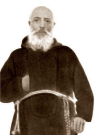 Fra’ Camillo da Sant’Elia a Pianisi, was a search brother stationed in the
convent of Morcone. He, stopping by the Forgione farm in Piana Romana
in his rounds of quest for alms, inspired Francesco with his beard and
the stories about St. Francis. Francesco told his parents: “I want to be a friar
with a beard, like fra’ Camillo.”[111]
[112]
In later years, Padre Pio remembering those times, said: “The beard of Fra’
Camillo was so much impressed in my mind that nobody could distract my desire to
become a bearded friar.”[113]
[114]
[115]
[116]
[117]
Fra’ Camillo da Sant’Elia a Pianisi, was a search brother stationed in the
convent of Morcone. He, stopping by the Forgione farm in Piana Romana
in his rounds of quest for alms, inspired Francesco with his beard and
the stories about St. Francis. Francesco told his parents: “I want to be a friar
with a beard, like fra’ Camillo.”[111]
[112]
In later years, Padre Pio remembering those times, said: “The beard of Fra’
Camillo was so much impressed in my mind that nobody could distract my desire to
become a bearded friar.”[113]
[114]
[115]
[116]
[117]
Francesco had very limited formal schooling. He did not frequent the three years
of public schools in his village. His parents started having second thoughts
about raising him as an illiterate farmer and shepherd, when Francesco expressed
the desire to go to school, and he seemed motivated to learn. They decided to
send him to school when he was ten.[118]
Luigi Peroni quotes 2 Samuel, 8-9: “I took you from the pasture, from following
the flock, to become ruler over my people Israel. I will make your name like
that of the greatest on earth.”[119]
His first teacher was Cosimo Scocca, a family friend from a nearby farm in Piana
Romana, who had a fifth grade education. He introduced him to the Alphabet when
Francesco was about ten.[120]
His first teacher was Mandato Saginato (also mentioned as Mennato Saginario)[121],
an artisan who worked hemp during the day as a rope maker, and used to teach
basic reading and writing to four or five kids at night for half lira per month.[122]
[123]
A town priest don Nicola Caruso also gave Francesco some teaching.[124]
Ubaldo Vecchiarino was one of the night students. He reported that Francesco was
the only one to answer the questiond of the teaches “Because he studied during
the day, and we didn’t care, and we have stayed shepherds and hoers.”[125]
Another was Vincenzo Salmone. He reported “I always asked him to leave the books
and play with us. He just smiled and kept studying.”[126]
Starting in September 1898, at age 11, Francesco begun private lessons with
Domenico Tizzani, "per cinque lire al mese." Tizzani apparently had been
relieved of his duties as a parish priest because he had ignored his vows of
celibacy. He lived with his wife and daughter, and spent all of his time at home
because he was ashamed to go out.[127]
The tuition of five lire per month was quite a bit in those days.[128]
In the beginning Francesco learned and made good progress with don Tizzani, to
the point that zi’ Grazio asked him to buy in Benevento the book of Latin for
Francesco,
[129]
but on time he felt uncomfortable. Don Tizzani one day called the boy’s mother
and said: “Send your son to be a shepherd, because that’s all he is good for.”[130]
[131]
After few months with don Tizzani, he changed teacher.[132]
In Pietrelcina, years after his ordination to priesthood Padre Pio was passing
one day by Tizzani’s home and saw his daughter Assunta crying on the steps
before the house. Her father was dying and no one had the courage to approach
him. Padre Pio asked permission, entered, and brought him reconciliation with
God and eternal salvation for his soul. The dying man made his confession with
don Giuseppe Orlando, and died with the comfort of the Sacraments.[133]
[134]
[135]
Pad Pio also obtained that he have a funeral in church dressed with the priestly
robes.[136]

 Ships with migrants at the times of Zi' Grazio Forgione.
Ships with migrants at the times of Zi' Grazio Forgione.
Francesco about his childhood : "In my home you hardly found a penny, but we
never missed anything"[137]
[138]
To make money to pay for Francesco's studies Grazio Forgione went to work across
the ocean. It seems that over the years until his death in 1946 nobody asked zi’
Grazio about his trips to America, and if anybody did there is no written
testimony about it. Probably he went to Brazil or Argentina in 1897, but came
back without money. Also probably in 1899 he worked for the Erie Railroad,[139]
and later went to work in Mahoningtown, near New Castle, in Pennsylvania, as a
farm laborer. He stayed with a cousin and brought some money home.[140]
[141]
[142]
He was able to repay a loan of one hundred lire received from don Tizzani when
Francesco started studying with him.”[143]
Padre Pio later recalled: "My father crossed the ocean twice to give me the
possibility to become a friar."[144]
First Communion and Confirmation
Padre Pio received the First Communion on 27 September 1899, at age 12, and was
confirmed the same day by the Archbishop of Benevento Mons. Donato Maria
Dell'Olio in the church of St. Anne, in Pietrelcina.[145]
[146]
Years later Padre Pio recalled the day of his Confirmation: “The day of my
confirmation was very special and I will never forget it in my life. The Holy
Spirit gave me special emotions. Remembering that day I feel like I am burned by
a very lively flame.”
[147]
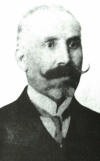
 Francesco's teacher Angelo Caccavo. His desk preserved in
Pietrelcina's museum.
Francesco's teacher Angelo Caccavo. His desk preserved in
Pietrelcina's museum.
Francesco had completed the studies of the first three years of elementary
school with Tizzani, when he left him and went to study with Angelo Caccavo.
Caccavo, a former seminarian, was a teacher in the public schools and also had
night classes at his home. Francesco stayed with him for three years, from 1900
to 1902. With him Francesco passed the exams for his elementary diploma, and
passed also the tests for admission to high school.[148]
With Caccavo, Francesco changed from a poor pupil to a brilliant one.[149]
He was the first of the class.[150]
A notebook with 30 themes developed by Padre Pio when he studied with Caccavo is
still preserved to these days.[151]
devil
Don Nicola
Caruso, a priest living in Pietrelcina, reported that when Francesco went home
from school at night he would find many times a priest standing on the doorway
of his home. He did not let Francesco get in the house. Then, a barefoot child
would come, and make the sign of the cross, and the priest would disappear.[152]
The boys in Caccavo’s class drafted a love letter, signed in Francesco’s name,
and delivered it to one of the girls. She handed it over to Caccavo. The teacher
beat the boy severely in front of the class. When Caccavo learned that the note
was a forgery he was horryfied. He regretted the beating for the rest of his
life.[153]
[154]
[155]
Padre Pio later said: “All his remorse could not take away the black And blue
marks that I carried about for days.”[156]
The image of "Madonna di Pompei and the internal of the Sanctuary.
In 1901 Padre Pio made a pilgrimage to Pompeii with his teacher Angelo Caccavo
and seven schoolmates. He explained in a letter to his father in America, on
October 5, 101, about the pilgrimage, and why he had wasted some few lire, and
told him of his resolution to become a friar: “Next year I will abandon this
life to embrace a better one.”[157]
Francesco had decided to consecrate his life to God since age five. He had also
chosen the Capucin order to become “a friar with the beard”. The minimum age to
enter the Capuchin novitiate is 15. Francesco turned 15 on May 5, 1915. The
archpriest Salvatore Pannullo wrote a letter of recommendation, Padre Pio was
not accepted because the novitiate was already full. Pannullo was told that
there would be an opening after the Christmas holidays, in January 1903.[158]
In a letter to Nina Campanile in November, 1922 Padre Pio reported the
excruciating interior fights that he endured when he has about to enter the
novitiate 20 years before, in 1903. “There were two powers inside me, and they
fought each other, and they tore my heart; the world wanted me all for itself,
and God called me to a new life.”[159]
And he told God: “You hid me from everyone’s eyes, and entrusted me with a grand
mission; a mission that is known only to You and me.”[160]
“I hear constantly a voice inside me saying: Sanctify yourself and sanctify
others.”[161]
The battle plan: Three Visions.
In the days before entering the
novitiate Padre Pio had three visions. He reported those years later under
obedience to his superiors in a manuscript. The transcript is now included in
appendix to the Epistolary, part I.[162]
Right after Christmas in December 1902, he had a vision: “An immense hall richly
adorned and splendidly lighted. On one side there were many people of
extraordinary beauty. On the other side, horribly looking people. Jesus took my
arm and walked me to the center of the hall. At that point from the back advance
a gigantic beast coming forward with the attitude of devouring me. I was scared
but Jesus encouraged me. When the monster went close to me he uttered an
infernal shout, and fell stricken dead. Jesus said: “This is what you will have
to fight.” And the vision disappeared.”[163]
A
great multitude divided in two camps, one shining, and the other dark. A
gigantic monster headed the dark. A majestic man of rare beauty heading the
other ordered Francesco to fight the monster. He did and won. The majestic man
said: "The monster you have defeated is the devil and you will fight this enemy
for the rest of your life."[164]
On January 1, 1903, after receiving the Communion he was suddenly enveloped by
an interior light and he understood that by entering the service of the Lord he
was exposing himself to the unending fight with the devil.[165]
On January 5, 1903, during the night, Francesco had a vision of Jesus and Mary
encouraging him to go on with his plan to enter religious life. "My last night
at home Jesus and his Mother came to assure me of their predilection".[166]

Francesco entered the novitiate in Morcone on January 6, 1903.[167]![]()
Agostino, d. S. (2012). Diario. San
Giovanni Rotondo: Edizioni Padre Pio.
Ago12
Alessando, da Ripabottoni (Saint Pio of Pietrelcina. Everybody's Cyrenean).
2010. San
Giovanni Rotondo: Edizioni Padre Pio. Ale010
Capuano, P. (2012). Con p. Pio: come in una fiaba. Foggia: Grafiche
Grilli. Cap12
Castelli, F. (2011). Padre Pio under investigation. The secret Vatican files.
San Francisco: Ignatius Press. Cas11
Convento. (2001). Padre Pio dalla Terra al Cielo. San Giovanni Rotondo:
Edizioni Frati Cappuccini. Con01
De Rossi Giuseppe, (. B. (2008). Padre Pio da Pietrelcina. Collana SAO.
Der08
DeLiso, O. (1962). Padre Pio. New York: All Saints Press.
Del62
Duchess, o. S. (1968). Magic of a Mistic. Stories of Padre Pio. New York:
Clarkson N. Potter. Duc68
Giannuzzo, E. (2012). San Pio da Pietrelcina. Il travagliato persorso della
sua vita terrena. Book sprint edizioni.
Gia12
Gigliozzi, G. (1965). Padre Pio. New York: Pocket Cardinal Edition.
Gig65
Ingoldsby, M. (1978). Padre Pio. His Life and Mission. Dublin: Veritas
Publications. Ing78
Leone, G. (1976). Padre Pio, infanzia e prima giovinezza. San Giovanni
Rotondo: Edizioni Padre Pio. Leo76
Malatesta, E. (2002). Aiutatemi tutti a portare la Croce. Milano: Il
Saggiatore. Mal02
McGregor, A. (1981). Padre Pio: His Early Years. San Giovanni Rotondo:
Edizioni Padre Pio. McG81
Modestino, F. d. (2001). Io testimone del Padre. San Giovanni Rotondo:
Edizioni Padre Pio. Mod01
Mortimer Carty, f. C. (1973). Padre Pio the stigmatist. TAN Books.
Car73
Multiple. (2009). Padre Pio The wonder worker. New Bedord, MA: Franciscan
Friars of Immaculate. Mul09
Napolitano, F. (1978). Padre Pio of Pietrelcina. A brief biography. San
Giovanni Rotondo: Edizioni Padre Pio.
Nap78
Parente, P. (1968). A city on a Mountain. Washington, NJ: Ave Maria
Institute. Par68
Peroni, L. (2002). Padre Pio da Pietrelcina. Borla.
Per02
Pietrelcina, P. P. (2011). Epistolario I Corrispondenza con i direttori
spirituali (1910-1922). San Giovanni Rotondo: Edizioni Padre Pio.
Epist. I
Pietrelcina, P. P. (2012). Epistolario III, corrispondenza con le figlie
spirituali (1915-1923). San Giovanni Rotondo: Edizioni Padre Pio.
Epist. III
Pietrelcina, P. P. (2012). Epistolario IV, corrispondenza con diverse
categorie di persone. San Giovanni Rotondo: Edizioni Padre Pio.
Epist. IV
Preziuso, G. (2000). The life of Padre Pio between the altar and the
confessional. New York: Alba House.
Pre00
Rega, F. M. (2005). Padre Pio and America. Rockford: TAN books.
Reg05
Riese, F. d. (2008). Padre Pio da Pietrelcina crocifisso senza croce. San
Giovanni Roronto: Edizioni Padre Pio.
Fer08
Ripabottoni, A. d. (1970). Pio da Pietrelcina, Infanzia e adolescenza.
San Giovanni Rotondo: Edizioni Padre Pio.
Ale70
Ripabottoni, L. d. (1976). Beata te, Pietrelcina. San Giovanni Rotondo:
Edizioni Padre Pio. Ale76
Ruffin, C. B. (1991). Padre Pio: the true story. Huntington, Indiana: Our
Sunday Visitor, Inc. Ruf91
Saldutto, P. G. (2001). Il cammino di Padre Pio. Edizioni Piemme.
Sal01
Winowska, M. (1988). Il vero volto di Padre Pio. Milano: Edizioni San
Paolo.
Win88
[1] Fer10, 36
[2] Con01, 13
[3] Pio12, 8
[4] Con11, 15
[5] Gia12, 7-8
[6] Cap11, 6
[7] Ale70, 14
[8] Cap12, 92
[9] Mul99, 7
[10] Ruf91, 26-7
[11] Con01, 15
[12] Con01, 15
[13] Con01, 17
[14] Con01, 17-8
[15] Con01, 21
[16] Con01, 22
[17] Gia12, 8
[18] Con01, 25
[19] Leo76, 27
[20] Epist. I,
321
[21] Fer08, 51
[22] Duc68, 23
[23] Epist. III,
1006
[24] Cov07,
107-8
[25] Mul99, 8
[26] Per02, 23
[27] Per02, 23
[28] Leo76, 28
[29] Cap12, 92
[30] Per02, 24
[31] Leo76, 28
[32] Cap12, 92-3
[33] Leo76, 33
[34] Cas11, 276
[35] Ago12, 53
[36] Pre00,
11-12
[37] Per02, 25
[38] Per02, 26-7
[39] Fer08, 50
[40] Pre00, 11
[41] Cas11, 289
[42] Con01, 25
[43] Duc68, 23
[44] Fer10, 41
[45] Ale70, 17
[46] Fer10, 42
[47] Pre00. 12
[48] Duc68, 24
[49] Mod, 01
[50] Ale70, 65-6
[51] Pre00, 12
[52] Con01, 19
[53] Fer10, 50
[54] Ale010,
15-6
[55] Ale70, 14
[56] Pre00, 12
[57] Ruf91, 27
[58] Ruf91, 27
[59] Con01, 38
[60] Duc68, 24-5
[61] Con01, 38
[62] Duc68, 28
[63] Con01, 19
[64] Ale010, 13
[65] Cap12, 93
[66] Pre00, 16
[67] Leo76, 54-5
[68] Ale70, 31
[69] Fer10, 42
[70] Ale70, 32
[71] Pre00, 13
[72] Fer10, 43
[73] Ruf91, 31
[74] Cap12, 100
[75] Per02, 31
[76] Lin76, 113
[77] Ruf91,34
[78] Cap12, 112
[79] Con01, 41
[80] Epist. IV,
934
[81] Win88, 54
[82] Mor73, 1
[83] Pas68, 12
[84] Gig65, 26-7
[85] Cap12, 95
[86] Ruf91, 30
[87] Cap12, 94
[88] Per02,
32-33
[89] Leo76, 75-6
[90] Ing75, 7-8
[91] Pre00, 15-6
[92] Cap12, 96
[93] Cap12, 96
[94] Ruf91, 32
[95] Con01, 38
[96] Gig65, 22-3
[97] Con01, 31
[98] Del62, 18
[99] Con01, 37
[100] Con01,
31-7
[101] Del62, 25
[102] Ale70,
37-8
[103] Sal01, 28
[104] Ruf91, 33
[105] Pre00,
13-4
[106] Cap12,
113-4
[107] Fer08, 46
[108] Cov07,
99-100
[109] Mal02,
picture 6 of photo insert.
[110] Ruf91, 407
[111] Gia12,21
[112] Cap12,
58-9
[113] Pre98, 23
[114] McG81, 83
[115] Pre00, 16
[116] Pre00, 16
[117] Con01, 38
[118] Fer10, 45
[119] Per02, 39
[120] Ruf91, 30
[121] Fer10, 46
[122] Leo76,
71-2
[123] Ruf99, 30
[124] Fer10, 45
[125] Fer10, 46
[126] Fer10, 46
[127] DeR08, 17
[128] Nap76, 16
[129] Per02,
48-9
[130] Gig65, 23
[131] Del62, 20
[132] Mor73, 2
[133] Cap12, 98
[134] Mult99, 17
[135] Nap76, 17
[136] Per02, 138
[137] Pas50, 11
[138] Con01, 18
[139] Del62,13-4
[140] Ruf91, 36
[141] Reg05,
6-10
[142] Per02, 50
[143] Per02, 49
[144] Mul99, 12
[145] Gia12, 22
[146] Pre00, 15
[147] Epist. I,
471
[148] Gig65,24
[149] Del62, 22
[150] Fer10, 47
[151] Mor73, 3-4
[152] Fernando,
44-5
[153] Mul99, 37
[154] Duc68, 26
[155] Cap12, 99
[156] Leo76, 28
[157] Epist. IV,
933-4
[158] Chi99, 27
[159] Epist. I,
1008
[160] Epist. I,
1009
[161] Epist. I,
1010
[162] Epist. I,
1280-4
[163] Ago12, 53
[164] Epist. I,
1280-2
[165] Epist. I,
1283-4
[166] Epist. I,
1284
[167] Cap12, 8